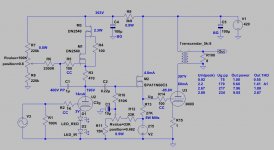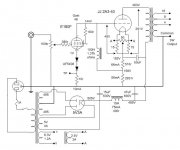Howdy everyone, as it usually happens in the life of the diy enthusiast I have came upon the quest of the 300b. Upon much reading and research I have opted to seek out a single driver design, be it a la we91a and driven by a pentode or maybe a different topography with a suitable triode.
What do you guys think? I was nearly ready to order all the parts necessary for Thorsten's legacy using c3m driver but before I pull the trigger I was wondering if there was any other design I should take into account. My only criteria is that its a single stage driver design. Please advise.
D.
What do you guys think? I was nearly ready to order all the parts necessary for Thorsten's legacy using c3m driver but before I pull the trigger I was wondering if there was any other design I should take into account. My only criteria is that its a single stage driver design. Please advise.
D.
ahh yes, thank you guys. D3a kinda escaped my first round of research.
I'm pretty set on not using an interstage, but was even flirting with the idea of some loftin-white time bomb.
The c3m has weird filament requirements but on paper looks really like an almost foolproof driver. The 6bm8 idea seems fun, thanks Eli I will look around and see if I can find some more about it.
Any comments on the possibility of a DHT as a driver?
I'm pretty set on not using an interstage, but was even flirting with the idea of some loftin-white time bomb.
The c3m has weird filament requirements but on paper looks really like an almost foolproof driver. The 6bm8 idea seems fun, thanks Eli I will look around and see if I can find some more about it.
Any comments on the possibility of a DHT as a driver?
As mentioned D3a and C3m / C3o / C3g are good. But don't overlook the high-gm video amp pentodes like 12GH7/12GN7. It's a bit dated but there's some test data here: High Gm driver pentodes
A few months ago I built this amp to my friend.
It's a little bit insensitive due to the transformer's high DCR, but sound is excellent. If you choose another -lower DCR- transformer (I like using 5k transformer and A2 driving), the sensitivity will be better.
ps: I use similar topology amp. First stage is D3a, green LED bias, cascode CCS.
It's a little bit insensitive due to the transformer's high DCR, but sound is excellent. If you choose another -lower DCR- transformer (I like using 5k transformer and A2 driving), the sensitivity will be better.
ps: I use similar topology amp. First stage is D3a, green LED bias, cascode CCS.
Attachments
Last edited:
ECC99, ECC88, E88CC, 6922, 6N6P, and d3A (triode strapped) are all great 300B drivers. 12BH7A is another common one. You need a low drive impedance for the 300B, though, as its input capacitance is on the order of 100 pF. I use a cathode follower. If you don't mind a little sand in the glass, a source follower works well here as well.
~Tom
~Tom
Hello,
Check D3A, E180F (cheap), E810F, E280F, EL802, C3M, 6S45P
Keep in mind those are high gm tubes and will need oscillation prevention measures, such as grid resistors.
Would you be able to provide some sample schematics? Anything tried and tested?
Why are schematics needed?  I don't understand. PDF files for tubes are available after a google search, as well as triode curves
I don't understand. PDF files for tubes are available after a google search, as well as triode curves
I have personally tried D3A, E180F, E810F, E280F, EL802. Now my amp runs on EL802. It's a high mu, high Pd driver. It's connected to a 6k interstage transformer. I recommend all of them, of course it depends of your price budget.
I have personally tried D3A, E180F, E810F, E280F, EL802. Now my amp runs on EL802. It's a high mu, high Pd driver. It's connected to a 6k interstage transformer. I recommend all of them, of course it depends of your price budget.
Here's my SE 2A3 amp using the E180F. One nice point about the E180F, besides the fact that it is excellent sounding, is that it is cheap to buy. I bought a dozen and got several pairs that matched for plate current at the operating point. Note the choke is by Electra-Print and the voltage on the cathode of the E180F is just over 1V. I had previously used a 6N23P-EV in the same amp although with LED bias. Replacing the 6N23P was a major step forward in reducing "glare" and increasing transparency.Examples are always nice.
Attachments
Anything tried and tested?
I use D3a, E280F (triode mode, mostly 10mA CCS load) as amplifier's -mostly 300B SE- first tube. I have about prefer of them Siemens E280F. Best holographic space, microdynamics and clarity -IMHO-. D3a is a little more dynamic, have firmer tone image
E180F is a good -and cheap- voltage amplifier tube, but a little bit "weak" to driving larger (A2 capable) triodes.
I tried 7788/E810F (I have four Philips SQ, and two Valvo pairs, best of them Valvo -green print Philips Herleen made-), but not of my cup of tea. It seems a bit boring. Triode mode E810F is a good tube for small signal amplifiers .... but large signal operation distortion a bit high, in many case twice the D3a or E280F distortion.
Palustris:
What were the specific op points?
The operating points are on the schematic: Ep = 144V; Eg = -1V; Ip = 10mA; gain = 46
Last edited:
- Home
- Amplifiers
- Tubes / Valves
- 300b with single stage driver, C3M or?

